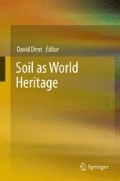Abstract
The prevailing farming system in Moldova has brought about a loss of humus, degradation of soil structure and compaction of the plough layer of chernozem soils. The most effective remedy is steppe vegetation. Fifteen years under grass fallow restored 80 % of the humus and 95 % of structural quality. Five years under lucerne had little effect; but growing a legume-and-grass mixture for 5 years restored tilth, the degraded plough layer was enriched with organic matter and plant residues (by 0.45 % or 0.1 % annually), soil structure improved and a sod began to form. Large-scale implementation of this method requires restoration of the livestock sector and allocation of 15–20 % of the land to perennial grasses.
Access this chapter
Tax calculation will be finalised at checkout
Purchases are for personal use only
Notes
- 1.
Haplic chernozem in World reference base for soil resources 2006.
- 2.
Haplic chernozem in World reference Base for soil resources 2006. Leached chernozem are close to Typical chernozem, distinguished mainly by deep leaching of carbonates.
References
Andries S (2007) Optimization of nutritional regimes and crop productivity. Pontos, Chisinau (Romanian)
Balan T (2007a) Compaction of Typical chernozem on the Balti steppe by agricultural use. In: Teodor R, Petru G (eds) Soil compaction – processes and consequences. Risoprint, Cluj-Napoca, pp 117–121 (Romanian)
Balan T (2007b) Degradation and remediation of properties of Typical chernozem from the Balti steppe. Mold Agric 7–8:37–39
Balan T, Cerbari V, Boincean BP, Boagii I (2007) Anthropogenic aspects of transformation of Typical chernozem on the Balti steppe and the problem of their sustainable use. In: Boincean B (ed) Proceedings of the international scientific-practical conference sustainable, including ecological, agriculture: results, problems, perspectives. Presa Universitaria Baltiana, Balţi, pp 14–17 (Romanian)
Cerbari V, Balan T (2010) Typical chernozem from the moist warm area of Nothern Moldova. In: Andries SV (ed) Soil quality monitoring (database, conclusions, prognosis, recommendations). Nicolae Dimo Research Institute for Pedology and Agrochemistry, Chisinau, pp 98–171 (Romanian)
Sidorov M, Vanicovici G, Coltun V et al (2006) Agrotechnics. Presa Universitaria Balteana, Balti (Romanian)
Author information
Authors and Affiliations
Corresponding author
Editor information
Editors and Affiliations
Rights and permissions
Copyright information
© 2014 Springer Science+Business Media Dordrecht
About this chapter
Cite this chapter
Cerbari, V., Ciolacu, T. (2014). Phyto-amelioration of Degraded Chernozem. In: Dent, D. (eds) Soil as World Heritage. Springer, Dordrecht. https://doi.org/10.1007/978-94-007-6187-2_36
Download citation
DOI: https://doi.org/10.1007/978-94-007-6187-2_36
Published:
Publisher Name: Springer, Dordrecht
Print ISBN: 978-94-007-6186-5
Online ISBN: 978-94-007-6187-2
eBook Packages: Earth and Environmental ScienceEarth and Environmental Science (R0)

